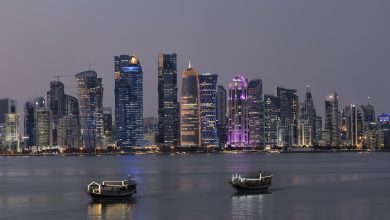
HMC cautions public about dangers of prolonged sun exposure
«حمد الطبية» تحذّر من التعرّض لضربات الشمس
Hamad Medical Corporation (HMC) has reminded the public to protect themselves and their families, especially young children and the elderly, from heat-related illnesses caused by high temperature and high humidity.
Dr Mahmoud Younis, assistant director of Health Promotion and Community Engagement with HMC’s Hamad International Training Centre, says the central nervous system, specifically the hypothalamus, is responsible for regulating temperature in the body.
“Just as a thermostat adjusts the temperature inside your home, the nervous system regulates your body’s temperature.
When your body loses its ability to self-regulate temperature, you risk developing a heat illness,” said Dr Younis.
The elderly, people taking medications that increase their sensitivity to sunlight, and individuals who are exercising or doing physical activity outdoors for long periods of time, are the most susceptible to developing a heat-related illness.
Dr Younis explains that the most serious form of heat illness, heatstroke, is a medical emergency and requires urgent treatment.
Left untreated, heatstroke can quickly damage the brain, heart, kidneys and muscles and lead to serious long-term complications and even death.
Headaches, stomach cramps and nausea can indicate dehydration and are often the first signs of a heat illness.
Other common symptoms include muscle pain, fatigue, nervousness, flushing or redness of the skin, shortness of breath, increased heartbeat and difficulty in concentrating.
Dr Younis says while heat exhaustion does not always lead to heatstroke, it is a warning sign and it is important to be vigilant for symptoms.
However, he notes that exposure to the sun can have many benefits, including boosting the body’s vitamin D supply and improving bone health.
“Avoid going out between 10am and 3pm when the sun is usually at its hottest.
Heat-related illness can progress rapidly, so any individual who is showing signs of a heat-related illness should immediately get out of the sun and into a shaded area.
It is essential to lower the body temperature by removing any heavy clothing and applying a cold compress, and to rehydrate by replenishing water the body has lost due to excessive sweating,” said Dr Younis.
He also warns about the dangers of sunburn, noting that while the redness, pain and swelling are all signs of inflammation and can be very uncomfortable, severe sunburns can have serious long-term health complications.
Dr Younis recommends being prepared. He says to plan ahead by drinking plenty of fluids, especially water, eating fresh fruits and vegetables and other high water-content foods, wearing lightweight, light-coloured, loose, clothing, sunglasses, a wide-brimmed hat and sunscreen.
He also recommends that individuals who have a pre-existing medical condition ask their doctor for advice on how to manage the heat.
Dr Younis says anyone who is experiencing signs and symptoms of a heat-related illness should seek medical attention, and those who are experiencing signs of heatstroke should get urgent medical care, or call 999 for HMC’s Ambulance Service.
دعت مؤسسة حمد الطبية سكان دولة قطر المواطنين والمقيمين إلي توخي الحذر ووقاية أنفسهم وذويهم – خاصة الأطفال وكبار السن- من أخطار الإعياء الحراري الناجم عن ارتفاع حرارة الجو وارتفاع درجات الرطوبة.
وأوضح الدكتور محمود يونس مساعد المدير لتعزيز الصحة والمشاركة المجتمعية بمركز حمد الدولي للتدريب في مؤسسة حمد الطبية، أن الجهاز العصبي يتحكم في ضبط حرارة الجسم وإبقائه في حالة صحية سليمة، فعندما ترتفع حرارة الجسم تجده يحاول الحفاظ على درجة الحرارة الطبيعية، مشيراً إلى أن الإنسان يصاب بالأمراض ذات العلاقة بالحر عندما لا يستطيع بدنه القيام بما يكفي فيما يتعلق بعملية التحول الحراري وإبقاء الجسم بحالته الطبيعية.
وحذر الدكتور يونس من المشكلات المرتبطة بحرارة فصل الصيف مثل الإجهاد الحراري أو الإنهاك الحراري الذي يحدث بسبب التعرض للحرارة المرتفعة المصحوبة بجفاف الجسم، وقد يسبب الوفاة في بعض الأحيان إذا لم يتم الانتباه للأعراض وتدارك الأمر بشكل سريع؛ وكذلك ضربات الشمس التي تسبب ارتفاع درجة حرارة الجسم نتيجة التعرض المباشر لأشعتها، والحروق الناتجة عن التعرض المباشر لأشعة الشمس يومياً مما يؤدي إلى حروق متعددة بالجسم.
وأشار الدكتور يونس إلى أن ضربة الشمس تأتي كنتيجة للتعرض المطول لأشعة الشمس أو الحرارة المرتفعة، وعند ذلك يفقد الجسم القدرة على إخراج الحرارة، ويسبب بقاؤها في الداخل ضرراً على الأعضاء الحيوية في حالات قليلة، وفي حالات أخرى تؤدي إلى آلام حادة في الرأس مع فقدان الجسم السوائل ما يسبب آلاماً عضلية وإرهاقاً وعصبية شديدة، إضافة إلى الغثيان والقيء، واحمرار وتوهج الجلد، وزيادة سرعة التنفس، وتسارع ضربات القلب، وصعوبة التكلم وعدم فهم ما يقوله الآخرون، مضيفاً: «لذا ينبغي عند ملاحظة ظهور هذه الأعراض نقل الشخص المصاب إلى منطقة مبرّدة بالتكييف وإبقائه في وضعية الاستلقاء وإعطائه الكثير من السوائل، مع الحرص على نزع الملابس الثقيلة واستخدام الكمّادات الباردة بهدف خفض درجة حرارة الجسم».
وأشار الدكتور يونس إلى الآثار النافعة للتعرض لأشعة الشمس، لعل من أبرزها أنها تعد مصدراً أساسياً لإمداد الجسم بفيتامين (د) للحفاظ على صحة العظام من الهشاشة، ولكن نحاول بقدر الإمكان اختيار الأوقات المناسبة، التي غالباً ما تكون خلال الفترة من الصباح الباكر حتى العاشرة صباحاً. ويفضل تجنب التعرض المستمر والمباشر لأشعة الشمس خلال فترة الظهيرة من الساعة العاشرة صباحاً حتى الثالثة عصراً، حيث غالباً ما تكون الأشعة في أوج شدتها في تلك الفترة.
واستعرض الدكتور يونس بعض النصائح التي من شأنها أن تخفف من وطأة الحرارة العالية؛ ومن أهمها شرب الكثير من السوائل وخاصة الماء، والإكثار من تناول الفواكه، وارتداء الملابس القطنية الفاتحة، وكذلك ارتداء القبعات لحماية الرأس من أشعة الشمس الحارقة خاصة للأطفال وكبار السن، والأهم من ذلك، تجنّب الخروج والتعرض لأشعة الشمس إلا في حالات الضرورة القصوى، وضرورة التوجه إلى الطوارئ على الفور أو الاتصال على الرقم (999) في حال تعرض الشخص للإعياء الحراري أو الحروق؛ حيث قد يؤدي ذلك إلى مشاكل خطيرة، إضافة إلى تجنّب العمل في الأماكن المفتوحة خلال فترة الظهيرة بالصيف، كما يجب التعرّف على كيفية المعالجة للمصاب بالإجهاد الحراري وضربات الشمس وكيفية إجراء الإسعافات الأولية للمصاب.;



